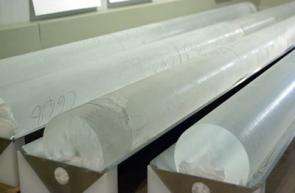Old ice provides insights into major climate change

All cold periods throughout the past 740,000 years were associated with a significantly larger sea ice cover around the Antarctic than warm periods. At the same time, South America’s south was significantly drier and windier than nowadays, leading to a much higher dust deposition in the Antarctic.
These are some of the results published this week in the scientific journal Nature as part of a study on aerosols retrieved from an ice core 3 kilometres long, carried out by a European team of scientists with participation of the Alfred Wegener Institute for Polar and Marine Research.
Change of Antarctic sea ice cover
The ice core obtained in December 2004 as part of EPICA (European Project for Ice Coring in Antarctica) from Dome C in the eastern Antarctic (75° 06’S, 123° 21’E) covered more than eight consecutive alternations of ice ages and warm periods (glacial cycles). Thus, the core represents the longest continuous ice core archive ever retrieved. For their investigation, the EPICA scientists measured concentrations of aerosols within the ice, tracing the minute particles which had originated at the ocean surface or on continents far away and had been transported by wind to the Antarctic. The concentration of sea salt aerosol, for instance, formed in the process of seawater freezing, indicates a large scale expansion of sea ice cover around the Antarctic during all cold periods.
No increase in biological activity
Rising concentrations of small mineral dust particles during cold periods suggest a drier climate in the neighbouring continents, especially South America. The dust carried into the Southern Ocean by wind, provides additional nutrients for plankton in the surface ocean. However, analyses of sulphate aerosols from the ice core, produced after algal blooms, do not point towards an increase in biological activity in the Southern Ocean. “Our results require a revision of previous perspectives on the biological response to climate change in the Southern Ocean. At least for southern parts of that ocean, our perception about increased biological productivity during ice ages needs to be reconsidered”, suggests Hubertus Fischer, head of the chemical investigations at the Alfred Wegener Institute.
Predicting the future from viewing the past
After the analysis of temperature changes throughout the past eight climate cycles, the recent investigation of dissolved chemical components from the ice core represents another important step towards the evaluation of historical changes in climate. “Our research results reveal a similar succession of identical changes, whenever warm climate conditions alternated with cold ones over the past 740,000 years”, explains Eric Wolff of the British Antarctic Survey, primary author of the current publication. “This leads us to conclude that the Earth follows certain rules in the process of changing climates. If we can understand these rules, we will be able to improve our climate models and hence our predictions of the future.”
Source: Alfred Wegener Institute for Polar and Marine Research















